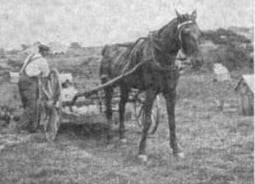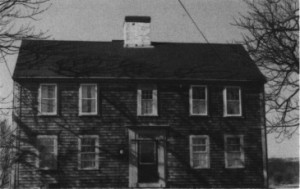Yesterday, I wrote about the mystery suggested by two distinct gravestones for one person: Sally (Almy) Briggs of Little Compton, Rhode Island. My research story continues:
While searching an anthology entitled Little Compton Families, a tome which chronicled the family history of many of the town’s most well-established clans, I found one fact which had not been mentioned in any previously examined sources. According to this source, Sally Almy’s gravestone “is at the F.W.C. Almy Place.”[7]
Basic research indicated that Fred W.C. Almy (1872–1944) was known not only in Little Compton but around the world for one thing: his prize-winning Rhode Island Reds, the state bird of Rhode Island famed for its egg-laying ability. According to one source, the farm of F.W.C. Almy was “one of the most satisfactory farms to visit in the Little Compton District.” Furthermore, it is said that the farm was more than 125 acres in size and was devoted almost exclusively to poultry.[8] The property was known simply as “Red Feather Farm,” an obvious reference to the Rhode Island Reds. Was my girlfriend’s family’s house part of this widely known farm?
To find out, I consulted “Historic and Architectural Resources of Little Compton, Rhode Island,” a work published by the Rhode Island Historical Preservation Commission in 1990. Inside, I found an image that struck me. It showed the house where I found the original gravestone labeled as “Red Feather Farm.”[9]
I resolved to find out more so that I could share the findings with the family. I learned that the first known owner of the house was Sanford Almy (1759–1844), who left the farm to his son Oliver (1790–1873).[10] This interested me, as I had always assumed the home was owned by William Almy, Sally’s father; however, the families must have been related. The home remained in the Almy family until it was sold in 1947.[11]
I found a man named Sanford Almy in the 1790 Census living in Little Compton, surely the same man who owned the property that would become the F.W.C. Almy farm.[12] I also found a copy of the deed between Sanford Almy and his son, Oliver H. Almy, verifying that the home did change hands between these two early on in its history.[13]
 F.W.C. Almy and his daughter feeding their chickens (From Dwight Edward Hale, Standard-Bred Rhode Island Reds, Rose and Single Comb, 1911)
F.W.C. Almy and his daughter feeding their chickens (From Dwight Edward Hale, Standard-Bred Rhode Island Reds, Rose and Single Comb, 1911)
While the farm was owned by F.W.C. Almy, the property was covered in 8x12 shed-roofed colony houses that held as many as fifty chickens each.[14] While much of the farm was used for housing and raising poultry, a portion of the land was also devoted to growing oats, corn, and vegetables for winter feedings.[15] Overall, the farm could comfortably house and care for as many as 2,000 to 2,200 chickens.[16] The eggs, which generally sold for 30 to 33 cents a pound, were taken to the nearby Tiverton train station, where they were sent on to the best hotels in Boston.[17]
As it turned out, the home where I ate Thanksgiving dinner had quite a history that was lying just beneath the surface. These discoveries were all the result of a curiosity piqued by a displaced gravestone. By uncovering the history of the individual represented on the gravestone, I was able to discover much about the place where she is buried. While I never found out why Sally Almy had two gravestones (a mystery I will continue to unravel and hopefully share at a later date), I found the history of the home of a dear friend, including stories and images that I will continue to share with her family throughout the holidays.
Notes
[7] Benjamin Franklin Wilbour, Little Compton Families (Baltimore: Genealogical Publishing Company, 2003), p. 65.
[8] Cyphers Incubators Co., Cyphers Series on Practical Poultry Keeping 1 [1911]: 36.
[9] The Rhode Island Historical Preservation Commission, “Historic and Architectural Resources of Little Compton, Rhode Island” (1990), p. 37.
[10] Ibid., p. 75.
[11] Ibid., p. 37.
[12] Household of Sanford Almy, 1790 United States Census, Little Compton, Newport Co., R.I.
[13] Little Compton, Rhode Island Land Deeds, Book 9, p. 288, Sanford Almy to Oliver H. Almy.
[14] Dwight Edward Hale, Standard-Bred Rhode Island Reds, Rose and Single Comb: Their Practical Qualities; the Standard Requirements; How to Judge Them; How to Mate and Breed for Best Results (Quincy, Ill.: Reliable Poultry Journal Publishing Co., 1911), p. 79.
[15] Ibid., p. 80.
[16] Ibid., p. 81.
[17] Prince T. Woods, “Fred W.C. Almy and Red Feather Farm,” American Poultry Journal 45 [1914]: 812.
Share this:
About Zachary Garceau
Zachary J. Garceau is a former researcher at the New England Historic Genealogical Society. He joined the research staff after receiving a Master's degree in Historical Studies with a concentration in Public History from the University of Maryland-Baltimore County and a B.A. in history from the University of Rhode Island. He was a member of the Research Services team from 2014 to 2018, and now works as a technical writer. Zachary also works as a freelance writer, specializing in Rhode Island history, sports history, and French Canadian genealogy.View all posts by Zachary Garceau →
